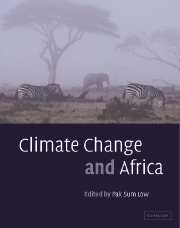Book contents
- Frontmatter
- Contents
- Notes on contributors
- Peer reviewers
- Editor's note
- Foreword
- Foreword
- Foreword
- Foreword
- Preface
- Preface
- Preface
- Preface
- List of abbreviations
- List of SI prefixes
- List of unit abbreviations
- List of chemical formulae
- Part I Science
- Part II Sustainable energy development, mitigation and policy
- Part III Vulnerability and adaptation
- 18 Potential impacts of sea-level rise on populations and agriculture
- 19 Sea-level rise and coastal biodiversity in West Africa: a case study from Ghana
- 20 The impacts of ENSO in Africa
- 21 Climate policy implications of the recent ENSO events in a small island context
- 22 El Niño causes dramatic outbreak of Paederus dermatitis in East Africa
- 23 The role of indigenous plants in household adaptation to climate change: the Kenyan experience
- 24 Requirements for integrated assessment modelling at the regional and national levels in Africa to address climate change
- 25 Climate and disaster risk reduction in Africa
- Part IV Capacity-building
- Part V Lessons from the Montreal Protocol
- Index
22 - El Niño causes dramatic outbreak of Paederus dermatitis in East Africa
Published online by Cambridge University Press: 10 December 2009
- Frontmatter
- Contents
- Notes on contributors
- Peer reviewers
- Editor's note
- Foreword
- Foreword
- Foreword
- Foreword
- Preface
- Preface
- Preface
- Preface
- List of abbreviations
- List of SI prefixes
- List of unit abbreviations
- List of chemical formulae
- Part I Science
- Part II Sustainable energy development, mitigation and policy
- Part III Vulnerability and adaptation
- 18 Potential impacts of sea-level rise on populations and agriculture
- 19 Sea-level rise and coastal biodiversity in West Africa: a case study from Ghana
- 20 The impacts of ENSO in Africa
- 21 Climate policy implications of the recent ENSO events in a small island context
- 22 El Niño causes dramatic outbreak of Paederus dermatitis in East Africa
- 23 The role of indigenous plants in household adaptation to climate change: the Kenyan experience
- 24 Requirements for integrated assessment modelling at the regional and national levels in Africa to address climate change
- 25 Climate and disaster risk reduction in Africa
- Part IV Capacity-building
- Part V Lessons from the Montreal Protocol
- Index
Summary
Keywords
Paederus sabaeus; Nairobi Fly; outbreak; El Niño; Paederus dermatitis; conjunctivitis; Nairobi; Kenya
Abstarct
An outbreak of Paederus sabaeus rove beetles in Kenya during the 1997–1998 El Niño resulted in a dramatic increase of vesicular dermatitis in its capital Nairobi. The beetle, popularly called ‘Nairobi Fly’, contains a potent toxic fluid that causes epidermolysis and acute conjunctivitis. A cross-sectional epidemiological study involving 1, 208 Nairobi residents was conducted to determine the health impact of this outbreak. The results showed that one-third of the Nairobi population were infected during this period. The majority of the respondents reported lesions on exposed body parts above the shoulders. Disfiguring, painful blisters and skin rashes in and around the facial area had a strong personal and social impact. Policy makers and public health specialists need to recognize that outbreaks of insects of medical importance resulting from global climatic events require urgent remedial action.
INTRODUCTION
Modern human activities have an obvious negative impact on the environment and contribute to the irreversible alteration of the global climate. Evidence shows that successions of abnormal climatic events have a disturbing effect on the world's ecosystems (Epstein et al., 1998). Rise of temperatures and more frequent occurrence of extreme weather conditions alter the flora and affect the development of competitive insect species in certain parts of the world, causing unexpected insect explosions with consequences for human health (Dukes and Mooney, 1999).
- Type
- Chapter
- Information
- Climate Change and Africa , pp. 240 - 247Publisher: Cambridge University PressPrint publication year: 2005
- 5
- Cited by



